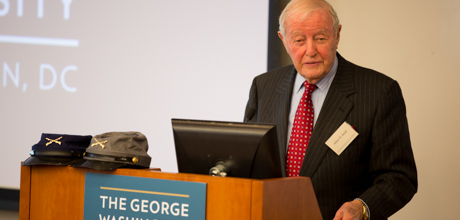During the Civil War, the District and nearby areas housed military hospitals, camps, prisons and nearly 70 forts and batteries protecting the city from Confederate troops. The District’s rich connections to the Civil War were highlighted at the Albert H. Small Washingtoniana Symposium Monday in the Elliott School of International Affairs State Room.
The event featured remarks from Mr. Small, president of Southern Engineering Corporation; GW trustee Robert G. Perry, B.S. ’70, chairman and president of the National Trust for the Humanities; Provost Steven Lerman; and GW Department of History Chair William Becker.
Professor of History Tyler Anbinder also presented on the District and the Civil War using Civil War-related items from the Albert H. Small Washingtoniana Collection, which contains more than 860 rare maps, drawings, letters and documents, lithographs and books relating to the history and evolution of the city of Washington and the nation’s capital.
Following the event, GW President Steven Knapp, Mr. Perry and GW Department of Geography Chair Elizabeth Chacko gave remarks at a lunch in the City View Room.
In February 2011, Mr. Small, a recipient of the Presidential Humanities Medal and the George Washington University President’s Medal, donated his collection to the George Washington University to help establish the George Washington University Museum, which will be located on the university’s Foggy Bottom Campus at 21st and G streets, NW. The new museum’s collections will be integrated into the university’s academic programs and digitized for full access.
The donation to GW builds on Mr. Small’s long history of preserving and sharing America’s heritage. In 2005, he donated the earliest known image of the White House—a watercolor done in 1801 by J. Benford—to the White House, where it now hangs.
Mr. Small’s Washingtoniana Collection will be permanently displayed in the 156-year old Woodhull House which will be renamed the Historic Woodhull House, Home of the Albert H. Small Washingtoniana Collection. A prominent space in the new museum will be named the Albert H. Small Center for National Capital Area Studies.
Slated to open fall 2014, the George Washington University Museum will also be the new home of the world-renowned Textile Museum and the university’s existing collection of fine art.
In his opening remarks, Mr. Perry said Mr. Small has the “collection bug,” noting Mr. Small has been collecting historical artifacts related to Washington, D.C. for more than 60 years.
Mr. Small—who was celebrating his 87th birthday—told the audience that the collection bug has still got him, lifting up two hats from the Civil War that he had purchased in Georgia just the week before.
“It doesn’t stop,” he said. “Literally everywhere I go, I come home with something else.”
Mr. Small said his collection contains items that showcase the many sites and structures in the District that were crucial to Union war efforts, including Fort Stevens in Northwest D.C. and Soldier’s Rest (a reception center for new troops) near the U.S. Capitol.
Provost Lerman said the Civil War-related items in the Albert H. Small Washingtoniana Collection have “deep historical significance” that amplifies the District’s historical relationship to the Civil War, and he thanked Mr. Small for making his collection available to the public.
“I really treasure this collection,” said Dr. Lerman. “I’m looking forward to having it housed in a permanent exhibition where we can display it and make it accessible to the public and the entire GW community.”
Dr. Becker said the Albert H. Small Washingtoniana Collection will provide the university with a comprehensive overview of the history of the District.
“What our hope is with the collection is that it becomes very much a fabric of the university, and that the university take from it how deeply embedded GW is in the history of the District of Columbia,” he said.
An expert in 19th-century American politics and the history of immigration and ethnicity in American life, Dr. Anbinder spoke about how the city changed after the Civil War, and the capital region’s “underappreciated role” in the war. Using images from the Albert H. Small Washingtoniana Collection, Dr. Anbinder described several of the important connections between the District and the Civil War, including Harewood Hospital (built on the country estate of future GW Board of Trustee member William Wilson Corcoran) and Camp Fry, which was located near Washington Circle and GW’s Foggy Bottom Campus.
Fifteen items from the collection, including an 1862 Arnold Map, a 1864 photograph of Union soldiers at Fort Stevens and a 1862 watercolor depicting the Second Battle of Manassas by Union solider Robert Knox Sneden, were on display at the symposium.
At the lunch, GW President Knapp thanked Mr. Small for his “extraordinary gift” to GW and for his “transformational support” of the George Washington University Museum. Dr. Knapp also noted this week’s groundbreaking for the George Washington University Museum and next month’s groundbreaking for a conservation and resource center at the Virginia Science and Technology Campus, which will serve as a state-of-the art conservation and storage facility to facilitate long-term study and care of all of the collections.
Dr. Knapp and Mr. Perry also presented Mr. Small with a birthday cake at the conclusion of the lunch.
Dr. Chacko lectured on Camp Fry, which housed invalid soldiers, warehouses for uniforms and military supplies and slaughter houses. Camp Fry began on the south side of Washington Circle and extended back toward the Potomac River. An associate professor of geography and international affairs, Dr. Chacko’s current research focuses on the use of cultural and social capital in community development and on ethnic imaging and the creation of ethnic space in U.S. cities.


